|
The usual suspects led to volatile trading last week — a weekend interest rate decline from the PBoC combined with weak Chinese economic data and the ongoing Greek saga. Disappointing U.S. economic data led to trader confusion regarding future Fed policy. Since the Federal Reserve has said it is data dependent, each new report is evaluated in terms of when the Fed might begin to normalize its fed funds interest rate. And in Europe, ECB President Mario Draghi continually repeats that the Bank will stay the course on its easing program.
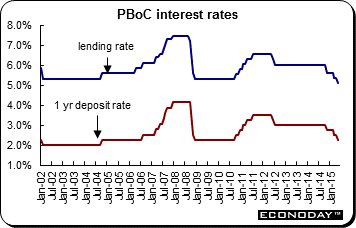 On Sunday, May 10, the People's Bank of China cut its one year benchmark rate by 25 basis points to 5.10 percent. The PBoC last cut rates on February 28, also by 25 basis points. The move was in response to the latest round of weak economic data. The Bank also cut the one year deposit rate by 25 basis points, to 2.25 percent. On Sunday, May 10, the People's Bank of China cut its one year benchmark rate by 25 basis points to 5.10 percent. The PBoC last cut rates on February 28, also by 25 basis points. The move was in response to the latest round of weak economic data. The Bank also cut the one year deposit rate by 25 basis points, to 2.25 percent.
The Bank said in an accompanying statement that it will "continue to promote real interest rates back towards reasonable levels". The tone of the comments was more aggressive than those of previous policy moves and suggests that the government's appetite for these kinds of adjustments will grow as long as China's low inflation/deflationary environment persists.
The move came after the government announced weaker than expected merchandise trade figures on Friday (May 8), with exports dropping 6.2 percent in April from a year earlier, and amid continuing signs of weakness in other parts of the economy. On Saturday, the government reported tepid consumer inflation ─ 1.5 percent in April compared with the same month last year.
By reducing interest rates, the government hopes to spur lending to businesses and create more momentum in the economy. Although China is still growing faster than any other major economy, the slowdown has accelerated in recent months. China reported that its economy grew just 7 percent on the year in the first quarter of this year, one of the lowest rates in a decade and far below decades of double digit growth. Later in the week, April data for industrial output and retail sales also disappointed.
|
|
2014 |
2015 |
% Change |
|
Index |
Dec 31 |
May 8 |
May 15 |
Week |
2015 |
| Asia/Pacific |
|
|
|
|
|
|
| Australia |
All Ordinaries |
5388.6 |
5635.4 |
5730.0 |
1.7% |
6.3% |
| Japan |
Nikkei 225 |
17450.8 |
19379.2 |
19732.9 |
1.8% |
13.1% |
| Hong Kong |
Hang Seng |
23605.0 |
27577.3 |
27822.3 |
0.9% |
17.9% |
| S. Korea |
Kospi |
1915.6 |
2085.5 |
2106.5 |
1.0% |
10.0% |
| Singapore |
STI |
3365.2 |
3452.0 |
3463.1 |
0.3% |
2.9% |
| China |
Shanghai Composite |
3234.7 |
4205.9 |
4308.7 |
2.4% |
33.2% |
|
|
|
|
|
|
|
| India |
Sensex 30 |
27499.4 |
27105.4 |
27324.0 |
0.8% |
-0.6% |
| Indonesia |
Jakarta Composite |
5227.0 |
5182.2 |
5227.1 |
0.9% |
0.0% |
| Malaysia |
KLCI |
1761.3 |
1807.7 |
1811.9 |
0.2% |
2.9% |
| Philippines |
PSEi |
7230.6 |
7763.2 |
7881.95 |
1.5% |
9.0% |
| Taiwan |
Taiex |
9307.3 |
9692.0 |
9579.5 |
-1.2% |
2.9% |
| Thailand |
SET |
1497.7 |
1510.5 |
1512.2 |
0.1% |
1.0% |
|
|
|
|
|
|
|
| Europe |
|
|
|
|
|
|
| UK |
FTSE 100 |
6566.1 |
7046.8 |
6960.5 |
-1.2% |
6.0% |
| France |
CAC |
4272.8 |
5090.4 |
4993.8 |
-1.9% |
16.9% |
| Germany |
XETRA DAX |
9805.6 |
11709.7 |
11447.0 |
-2.2% |
16.7% |
| Italy |
FTSE MIB |
19012.0 |
23312.4 |
23473.5 |
0.7% |
23.5% |
| Spain |
IBEX 35 |
10279.5 |
11424.7 |
11317.3 |
-0.9% |
10.1% |
| Sweden |
OMX Stockholm 30 |
1464.6 |
1616.5 |
1616.5 |
0.0% |
10.4% |
| Switzerland |
SMI |
8983.4 |
9093.3 |
9109.9 |
0.2% |
1.4% |
|
|
|
|
|
|
|
| North America |
|
|
|
|
|
|
| United States |
Dow |
17823.1 |
18191.1 |
18272.6 |
0.4% |
2.5% |
|
NASDAQ |
4736.1 |
5003.6 |
5048.3 |
0.9% |
6.6% |
|
S&P 500 |
2058.9 |
2116.1 |
2122.7 |
0.3% |
3.1% |
| Canada |
S&P/TSX Comp. |
14632.4 |
15170.0 |
15108.1 |
-0.4% |
3.3% |
| Mexico |
Bolsa |
43145.7 |
45126.0 |
45332.8 |
0.5% |
5.1% |
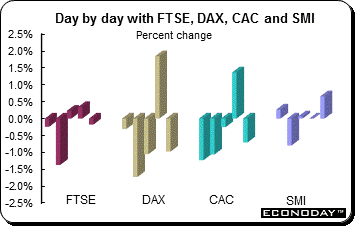 European equities were mixed last week despite an improvement in growth (except Germany) in the first quarter. The FTSE, CAC and DAX retreated 1.2 percent, 1.9 percent and 2.2 percent respectively. The SMI managed to increase 0.2 percent however. The indexes were headed to a positive end of the week on Friday until a spate of disappointing U.S. economic reports were released setting off a selling spree. European equities were mixed last week despite an improvement in growth (except Germany) in the first quarter. The FTSE, CAC and DAX retreated 1.2 percent, 1.9 percent and 2.2 percent respectively. The SMI managed to increase 0.2 percent however. The indexes were headed to a positive end of the week on Friday until a spate of disappointing U.S. economic reports were released setting off a selling spree.
Flash first quarter gross domestic product estimates were reported mid-week. However, the big disappointment was Germany which saw growth cut in half to 0.3 percent on the quarter.
The markets were up in early trading Friday on comments from ECB President Mario Draghi. Mr Draghi said in Washington DC speech stimulus efforts would remain in place until inflation picks up and companies and consumers gain confidence. Draghi reiterated commitment to "implement in full" the Bank's massive bond buying program, saying that the monetary stimulus will continue as long as needed.
A Greek central bank official said the country had to empty an emergency International Monetary Fund holding account to repay €750 million ─ due to the IMF. The move allowed Greece to avoid default but underscores the dire state of the country's finances as it continues to try to strike a deal with its creditors. Eurogroup Chairman Jeroen Dijsselbloem welcomed progress in Greece talks but he said more time is needed to bridge the remaining gaps and to reach a comprehensive agreement.
The European Bank for Reconstruction and Development (EBRD) lifted the outlook for central and southeastern European economies citing quantitative easing by the ECB, the weaker euro and lower oil costs. But Russia's deep recession is having a larger than expected negative spillover effect on countries with which it has strong economic links. In the latest Regional Economic Prospects, the EBRD projected overall stagnation in 2015 across all 35 countries covered and a meagre expansion of just 1.4 percent in 2016. Greece, the EBRD's newest recipient country, has been badly hit by fears it may default on its external debt obligations and exit the Eurozone. Greece is expected to stagnate this year before expanding 2 percent next year.
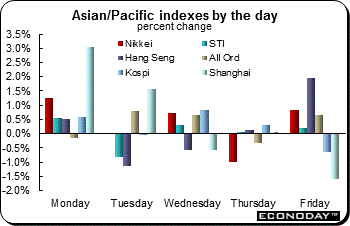 All equity indexes but Taiwan's Taiex were higher last week. Some calm returned to global bond markets and European Central Bank President Mario Draghi reiterated his pledge to keep economic stimulus policies in place "as long as needed" to stabilize prices, helping limit the downside in Friday's markets ahead of key U.S. data that were released after markets closed. Gains ranged from 0.1 percent (SET) to 2.4 percent (Shanghai Composite). All equity indexes but Taiwan's Taiex were higher last week. Some calm returned to global bond markets and European Central Bank President Mario Draghi reiterated his pledge to keep economic stimulus policies in place "as long as needed" to stabilize prices, helping limit the downside in Friday's markets ahead of key U.S. data that were released after markets closed. Gains ranged from 0.1 percent (SET) to 2.4 percent (Shanghai Composite).
The Shanghai Composite was volatile during the week, increasing as much as 3.0 percent on Monday after the People's Bank of China reduced interest rates over the weekend, only to drop 1.6 percent Friday on liquidity concerns that encouraged traders to lock in recent profits. The People's Bank of China played down market expectations that it would inject liquidity into the banking system under a program that lets commercial banks secure loans with local government debt. Equities were also sensitive to the fragile nature of the economy.
The Nikkei added 1.8 percent on the week on optimism about increased shareholder returns. A halt in the rise in global bond yields eased fears of increasing borrowing costs and domestic companies' strong earnings boosted investor optimism. As is usually the case, exporters' stocks here fluctuated inversely with the value of the yen. ECB President Mario Draghi said in a speech at the International Monetary Fund in Washington D.C. on Thursday that the ECB will continue its quantitative easing "as long as needed." This reassurance from Mr Draghi stopped European bond yields from rising further, and the stability in the bond market lent strength to U.S. stocks and then to the Tokyo market. Global bond yields' recent climb had weighed on stocks by spurring concerns that borrowing costs were set to rise and making equities a relatively less attractive investment.
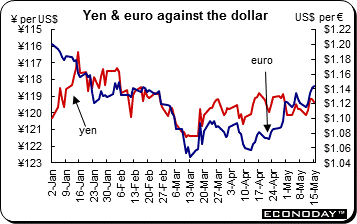 The U.S. dollar retreated against all of its major counterparts including the euro, yen, pound sterling, Swiss franc and the Canadian and Australian dollars last week. Disappointing U.S. economic data put in question when the Federal Reserve would begin its interest rate normalization process. It also muddled analysts' projections as to when this might occur. The U.S. dollar retreated against all of its major counterparts including the euro, yen, pound sterling, Swiss franc and the Canadian and Australian dollars last week. Disappointing U.S. economic data put in question when the Federal Reserve would begin its interest rate normalization process. It also muddled analysts' projections as to when this might occur.
On Thursday, the euro pared gains against the dollar in late trading, sparking a stock rally led by Germany's DAX index, which is packed with exporters. The increasing (decreasing) value of the euro is a negative (positive) for exporters — their products become more expensive (cheaper) while profits diminish (increase). The euro weakened slightly after European Central Bank President Mario Draghi said that the ECB's vast stimulus efforts will remain in place "as long as needed" until officials are confident they will meet their inflation objective on a sustained basis. The ECB's bond buying program has sent the euro sharply lower since it was first announced in January.
As recently as March, the dollar was looking so strong against the euro that the only question seemed to be how soon the eurozone currency would sink to parity. But the euro has been on a rebound and reached a three month high against the American currency, rising above $1.14. The euro began falling in the second half of last year after alarm about deflationary pressures pushed the European Central Bank to adopt a quantitative easing program. That program, which has the effect of driving down yields on Eurozone government bonds, sent investors scurrying to capital markets in the United States in search of higher returns, especially because the Federal Reserve had been expected to begin moving to raise interest rates from near zero. That wave of dollar-buying helped to drive a big rally in the currency, which gained sharply against most of its counterparts. But the euro, which fell as low as $1.0458 on March 16, has been clawing its way back. On Friday it was trading at $1.1444 and the highest level since February.
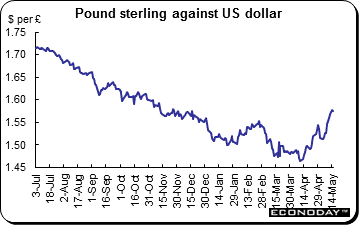 The pound sterling continues to celebrate the Conservative Party's election win. Despite the UK's current account deficit and the Bank of England cutting growth forecasts on Wednesday, relief at the decisive outcome of last week's general election has remained the dominant sentiment towards sterling in foreign exchange markets. The gains for the currency, which has jumped about 8 percent since touching a low for the year on April 10, have been helped by troubles in the U.S. dollar amid fresh concerns over the strength of the economic rebound this quarter and timing of a rate rise from the Federal Reserve. The pound sterling continues to celebrate the Conservative Party's election win. Despite the UK's current account deficit and the Bank of England cutting growth forecasts on Wednesday, relief at the decisive outcome of last week's general election has remained the dominant sentiment towards sterling in foreign exchange markets. The gains for the currency, which has jumped about 8 percent since touching a low for the year on April 10, have been helped by troubles in the U.S. dollar amid fresh concerns over the strength of the economic rebound this quarter and timing of a rate rise from the Federal Reserve.
|
|
2014 |
2015 |
% Change |
|
|
Dec 31 |
May 8 |
May 15 |
Week |
2015 |
| U.S. $ per currency |
|
|
|
|
|
|
| Australia |
A$ |
0.817 |
0.793 |
0.804 |
1.4% |
-1.6% |
| New Zealand |
NZ$ |
0.780 |
0.748 |
0.748 |
0.0% |
-4.1% |
| Canada |
C$ |
0.861 |
0.827 |
0.832 |
0.5% |
-3.5% |
| Eurozone |
euro (€) |
1.210 |
1.121 |
1.145 |
2.2% |
-5.4% |
| UK |
pound sterling (£) |
1.559 |
1.546 |
1.573 |
1.8% |
0.9% |
|
|
|
|
|
|
|
| Currency per U.S. $ |
|
|
|
|
|
|
| China |
yuan |
6.206 |
6.209 |
6.207 |
0.0% |
0.0% |
| Hong Kong |
HK$* |
7.755 |
7.753 |
7.751 |
0.0% |
0.0% |
| India |
rupee |
63.044 |
63.938 |
63.516 |
0.7% |
-0.7% |
| Japan |
yen |
119.820 |
119.740 |
119.330 |
0.3% |
0.4% |
| Malaysia |
ringgit |
3.497 |
3.599 |
3.565 |
1.0% |
-1.9% |
| Singapore |
Singapore $ |
1.325 |
1.328 |
1.320 |
0.6% |
0.3% |
| South Korea |
won |
1090.980 |
1088.340 |
1085.650 |
0.2% |
0.5% |
| Taiwan |
Taiwan $ |
31.656 |
30.699 |
30.449 |
0.8% |
4.0% |
| Thailand |
baht |
32.880 |
33.550 |
33.478 |
0.2% |
-1.8% |
| Switzerland |
Swiss franc |
0.9942 |
0.931 |
0.916 |
1.7% |
8.6% |
| *Pegged to U.S. dollar |
|
|
|
|
|
|
| Source: Bloomberg |
|
|
|
|
|
|
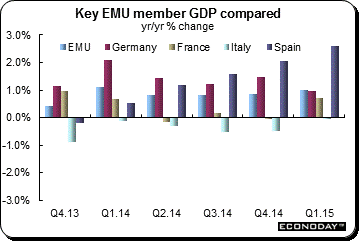 First quarter gross domestic product expanded 0.4 percent on the quarter and was up 1.0 percent from a year ago. In line with normal procedure, Eurostat provided no details of the latest GDP expenditure components. Growth was hindered by a sharp slowdown in Germany where total output expanded a quarterly 0.3 percent following a 0.7 percent rise at the end of last year. However, France (0.6 percent after 0.0 percent) was surprisingly robust and Spain (0.9 percent after 0.7 percent) posted its strongest performance in more than seven years. Italy (0.3 percent after 0.0 percent) saw its first positive print since the third quarter of 2013. Among the smaller countries Cyprus (1.6 percent after minus 0.4 percent) finally pulled out of recession but Finland (minus 0.1 percent after minus 0.2 percent) saw a second successive quarter of falling output. First quarter gross domestic product expanded 0.4 percent on the quarter and was up 1.0 percent from a year ago. In line with normal procedure, Eurostat provided no details of the latest GDP expenditure components. Growth was hindered by a sharp slowdown in Germany where total output expanded a quarterly 0.3 percent following a 0.7 percent rise at the end of last year. However, France (0.6 percent after 0.0 percent) was surprisingly robust and Spain (0.9 percent after 0.7 percent) posted its strongest performance in more than seven years. Italy (0.3 percent after 0.0 percent) saw its first positive print since the third quarter of 2013. Among the smaller countries Cyprus (1.6 percent after minus 0.4 percent) finally pulled out of recession but Finland (minus 0.1 percent after minus 0.2 percent) saw a second successive quarter of falling output.
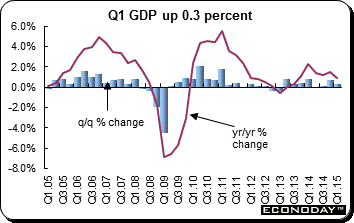 First quarter gross domestic product was up 0.3 percent on the quarter and was up 1.0 percent on the year. In the absence of any details on the GDP expenditure components, the German statistics office simply pointed out that the quarterly increase in total output came about as a result of stronger domestic demand. Household and general government consumption as well as fixed capital formation in construction and machinery and equipment saw solid gains. However, headline growth was hit by worsening net trade as a modest increase in exports was easily more than matched by imports. First quarter gross domestic product was up 0.3 percent on the quarter and was up 1.0 percent on the year. In the absence of any details on the GDP expenditure components, the German statistics office simply pointed out that the quarterly increase in total output came about as a result of stronger domestic demand. Household and general government consumption as well as fixed capital formation in construction and machinery and equipment saw solid gains. However, headline growth was hit by worsening net trade as a modest increase in exports was easily more than matched by imports.
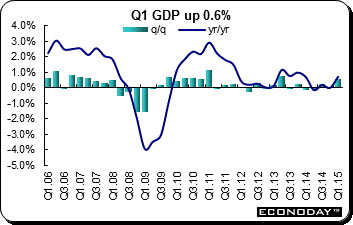 First quarter gross domestic product flash report indicated that the French economy increased 0.6 percent on the quarter and was up 0.7 percent from the same quarter a year ago. According to the flash report, the French economy enjoyed its best period since the second quarter of 2013 in the quarter just ended. The preliminary breakdown of the national accounts showed the rise in total output was dominated by household consumption which was up a quarterly 0.8 percent after just a 0.1 percent gain in the previous period. Government consumption rose 0.4 percent but private investment continued to decline, this time by 0.2 percent. Weakness here was again attributable to the housing market ─ residential investment fell 1.1 percent, its worst performance since the second quarter of 2014. Inventories added 0.5 percentage points. Growth would have been a lot stronger but for a marked deterioration in net exports which, having boosted growth by 0.2 percentage points in the fourth quarter, subtracted 0.5 percentage points at the start of the year. First quarter gross domestic product flash report indicated that the French economy increased 0.6 percent on the quarter and was up 0.7 percent from the same quarter a year ago. According to the flash report, the French economy enjoyed its best period since the second quarter of 2013 in the quarter just ended. The preliminary breakdown of the national accounts showed the rise in total output was dominated by household consumption which was up a quarterly 0.8 percent after just a 0.1 percent gain in the previous period. Government consumption rose 0.4 percent but private investment continued to decline, this time by 0.2 percent. Weakness here was again attributable to the housing market ─ residential investment fell 1.1 percent, its worst performance since the second quarter of 2014. Inventories added 0.5 percentage points. Growth would have been a lot stronger but for a marked deterioration in net exports which, having boosted growth by 0.2 percentage points in the fourth quarter, subtracted 0.5 percentage points at the start of the year.
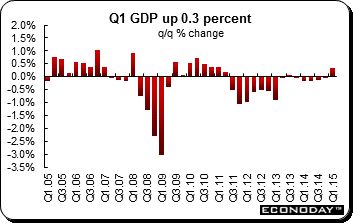 First quarter gross domestic product expanded for the first time since the third quarter of 2013. GDP increased 0.3 percent on the quarter and followed an unrevised zero rate in the fourth quarter. The gain lifted annual growth from minus 0.5 percent to 0.0 percent, the first non-negative print since the third quarter of 2011. As is usual with the flash estimate, Istat provided no details of the GDP expenditure components. However, it did indicate that output was up in both industry and agriculture but only flat in services. First quarter gross domestic product expanded for the first time since the third quarter of 2013. GDP increased 0.3 percent on the quarter and followed an unrevised zero rate in the fourth quarter. The gain lifted annual growth from minus 0.5 percent to 0.0 percent, the first non-negative print since the third quarter of 2011. As is usual with the flash estimate, Istat provided no details of the GDP expenditure components. However, it did indicate that output was up in both industry and agriculture but only flat in services.
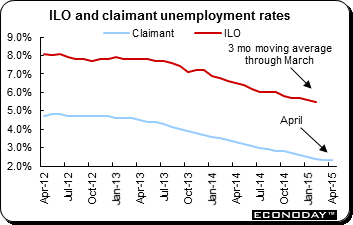 April's claimant count was down 12,600 on the month following a downwardly revised 16,700 drop in March. This was its smallest decrease since March 2013 but enough to leave the jobless rate unchanged at 2.3 percent. April was the first month since October 2014 that the unemployment rate has not declined. The ILO data painted a similar picture with the number of people out of work in the first quarter declining 35,000, its least marked decrease since June-August 2013. The unemployment rate on this measure was 5.5 percent. However, in contrast to the moderating growth signals from the jobs side, wage developments moved in the opposite direction. First quarter average earnings growth was an annual 1.9 percent, up a couple of ticks from the December-February rate. Similarly, excluding bonuses first quarter pay was up 2.2 percent on the year, a 0.3 percentage point increase versus last time. April's claimant count was down 12,600 on the month following a downwardly revised 16,700 drop in March. This was its smallest decrease since March 2013 but enough to leave the jobless rate unchanged at 2.3 percent. April was the first month since October 2014 that the unemployment rate has not declined. The ILO data painted a similar picture with the number of people out of work in the first quarter declining 35,000, its least marked decrease since June-August 2013. The unemployment rate on this measure was 5.5 percent. However, in contrast to the moderating growth signals from the jobs side, wage developments moved in the opposite direction. First quarter average earnings growth was an annual 1.9 percent, up a couple of ticks from the December-February rate. Similarly, excluding bonuses first quarter pay was up 2.2 percent on the year, a 0.3 percentage point increase versus last time.
 March industrial production was up 0.5 percent and was up 0.6 percent from the same month a year ago. Manufacturing added 0.4 percent and was 1.1 percent higher on the year. Within manufacturing, only six of the 13 reporting subsectors posted monthly gains. The strongest contribution was made by basic pharmaceutical products & pharmaceutical preparations where output jumped 6.7 percent and added 0.3 percentage points to the headline change. Other manufacturing & repair contributed 0.2 percentage points but there were small negative effects from a number of other categories. Overall production was further boosted by a 2.6 percent monthly increase in the volatile mining & quarrying subsector, mainly reflecting a surge in crude petroleum & natural gas (4.9 percent). However, the gain was almost offset by declines in water & waste management (0.3 percent) and electricity, gas, steam & air conditioning (1.1 percent). March industrial production was up 0.5 percent and was up 0.6 percent from the same month a year ago. Manufacturing added 0.4 percent and was 1.1 percent higher on the year. Within manufacturing, only six of the 13 reporting subsectors posted monthly gains. The strongest contribution was made by basic pharmaceutical products & pharmaceutical preparations where output jumped 6.7 percent and added 0.3 percentage points to the headline change. Other manufacturing & repair contributed 0.2 percentage points but there were small negative effects from a number of other categories. Overall production was further boosted by a 2.6 percent monthly increase in the volatile mining & quarrying subsector, mainly reflecting a surge in crude petroleum & natural gas (4.9 percent). However, the gain was almost offset by declines in water & waste management (0.3 percent) and electricity, gas, steam & air conditioning (1.1 percent).
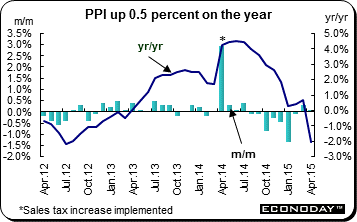 April producer prices edged up 0.1 percent on the month but dropped 2.1 percent from a year ago. Excluding the consumption tax, the PPI would have declined 2.2 percent on the year. The index was dragged down in part by a 23.4 percent drop in petroleum and coal prices. Prices in the other subcategories were mixed when compared with April 2014. April producer prices edged up 0.1 percent on the month but dropped 2.1 percent from a year ago. Excluding the consumption tax, the PPI would have declined 2.2 percent on the year. The index was dragged down in part by a 23.4 percent drop in petroleum and coal prices. Prices in the other subcategories were mixed when compared with April 2014.
 April retail sales were up 10.0 percent from a year ago, down from 10.2 percent in March. This was the slowest pace since February 2006. On the month, sales improved to 0.74 percent from 0.64 the month before. Year to date, sales eased to an increase of 10.4 percent from 10.6 percent. Urban sales also were lower, increasing 9.8 percent after 10.0 percent. Rural sales were up 11.4 percent, slipping from March's 11.5 percent increase. Among the subcategories, auto sales edged up 1.6 percent after retreating 1.3 percent the month before. Oil & oil products prices continued to decline, this time down 7.4 percent. Grain & food oil sales picked up while clothing sales eased. Household nondurables increased 11.8 percent after 15.6 percent in March while home appliance sales advanced 9.5 percent, down from 16.2 percent in March. April retail sales were up 10.0 percent from a year ago, down from 10.2 percent in March. This was the slowest pace since February 2006. On the month, sales improved to 0.74 percent from 0.64 the month before. Year to date, sales eased to an increase of 10.4 percent from 10.6 percent. Urban sales also were lower, increasing 9.8 percent after 10.0 percent. Rural sales were up 11.4 percent, slipping from March's 11.5 percent increase. Among the subcategories, auto sales edged up 1.6 percent after retreating 1.3 percent the month before. Oil & oil products prices continued to decline, this time down 7.4 percent. Grain & food oil sales picked up while clothing sales eased. Household nondurables increased 11.8 percent after 15.6 percent in March while home appliance sales advanced 9.5 percent, down from 16.2 percent in March.
 April industrial production improved to 5.9 percent from 5.6 percent in March on the year. However, it still missed forecasts for a 6 percent increase. The March figure was the slowest reading since November 2008. The lackluster data add to second quarter weakness already seen in last week's trade and inflation numbers. On the month, output was up 0.57 percent after rising 0.26 percent in March. For the year to date, production was up 6.2 percent after increasing 6.4 percent. Output improved for textiles, chemical, non-metal minerals and ferrous metals. However, output dropped for transportation equipment, machinery and communications. Motor vehicle production dropped 0.3 percent after increasing 3.5 percent the month before. April industrial production improved to 5.9 percent from 5.6 percent in March on the year. However, it still missed forecasts for a 6 percent increase. The March figure was the slowest reading since November 2008. The lackluster data add to second quarter weakness already seen in last week's trade and inflation numbers. On the month, output was up 0.57 percent after rising 0.26 percent in March. For the year to date, production was up 6.2 percent after increasing 6.4 percent. Output improved for textiles, chemical, non-metal minerals and ferrous metals. However, output dropped for transportation equipment, machinery and communications. Motor vehicle production dropped 0.3 percent after increasing 3.5 percent the month before.
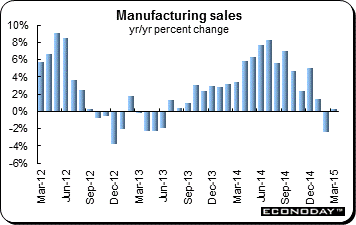 March manufacturing sales jumped 2.9 percent following back-to-back declines in both January and February. The monthly increase was only the second gain since September and more than reversed February's steeper revised 2.2 percent contraction. As a result, annual growth of shipments climbed from down 2.4 percent to plus 0.3 percent. The improvement in nominal sales was matched by volumes which also rose a solid 2.9 percent from February. Within the monthly increase in total nominal sales there were gains in ten of the twenty-one reporting subsectors. Aerospace was up 42.3 percent after a 29.4 percent slump last time and autos were 12.8 percent better off. There were also gains in food (3.0 percent) and miscellaneous manufacturing (1.8 percent). The largest negative contribution came from fabricated metal products which dropped 3.6 percent although both wood products (down 1.0 percent) and paper (down 0.8 percent) similarly struggled. March manufacturing sales jumped 2.9 percent following back-to-back declines in both January and February. The monthly increase was only the second gain since September and more than reversed February's steeper revised 2.2 percent contraction. As a result, annual growth of shipments climbed from down 2.4 percent to plus 0.3 percent. The improvement in nominal sales was matched by volumes which also rose a solid 2.9 percent from February. Within the monthly increase in total nominal sales there were gains in ten of the twenty-one reporting subsectors. Aerospace was up 42.3 percent after a 29.4 percent slump last time and autos were 12.8 percent better off. There were also gains in food (3.0 percent) and miscellaneous manufacturing (1.8 percent). The largest negative contribution came from fabricated metal products which dropped 3.6 percent although both wood products (down 1.0 percent) and paper (down 0.8 percent) similarly struggled.
The People's Bank of China eased interest rates for the third time since November 2014. The Eurozone economy began to show signs of growth even though Germany slowed. Most U.S. data disappointed, sending the U.S. currency lower against its major counterparts.
The Bank of Japan is expected to leave its monetary policy unchanged when it meets this week. Minutes from the Federal Reserve and Bank of England with keep bank watchers busy. Flash PMIs in Europe, Japan, China and the U.S. help economy watchers evaluate May.
| Central Bank activities |
|
| May 20 |
UK |
Bank of England Minutes of May Meeting |
| May 21 |
United States |
FOMC Minutes |
| May 21, 22 |
Japan |
Bank of Japan Monetary Policy Meeting |
| |
|
|
| The following indicators will be released this week... |
| Europe |
|
|
| May 18 |
Italy |
Merchandise Trade (March) |
| May 19 |
Eurozone |
Merchandise Trade (March) |
|
|
Harmonized Index of Consumer Prices (April final) |
|
Germany |
ZEW Survey (May) |
|
UK |
Consumer Price Index (April) |
|
|
Producer Price Index (April) |
| May 20 |
Germany |
Producer Price Index (April) |
| May 21 |
Eurozone |
Composite PMI (May flash) |
|
Germany |
Composite PMI (May flash) |
|
France |
Composite PMI (May flash) |
|
UK |
Retail Sales (April) |
| May 22 |
Germany |
Gross Domestic Product (Q1.2015 final) |
|
|
Ifo Survey (May) |
| |
|
|
| Asia/Pacific |
|
|
| May 18 |
Japan |
Machinery Orders (March) |
|
|
Tertiary Index (March) |
| May 20 |
Japan |
Gross Domestic Product (Q1.2015 first estimate) |
| May 21 |
Japan |
Manufacturing PMI (May flash) |
|
China |
Manufacturing PMI (May flash) |
| |
|
|
| Americas |
|
|
| May 22 |
Canada |
Consumer Price Index (April) |
|
|
Retail Sales (March) |
Anne D Picker is the author of International Economic Indicators and Central Banks.
|

